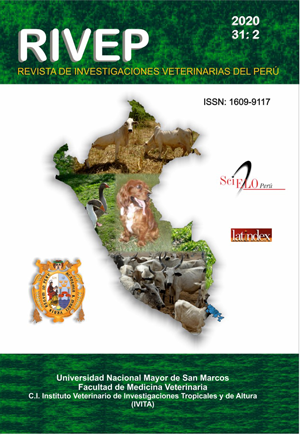Evaluation of animal welfare using behavioral indicators in a bovine slaughterhouse in Boyacá, Colombia
DOI:
https://doi.org/10.15381/rivep.v31i2.16213Keywords:
stress, protocol, indicators, desensitization, handlingAbstract
The aim of this study was to determine the behaviour and management practices related to the welfare of the animals destined for slaughter in an abattoir in the city of Sogamoso, Boyacá, Colombia. Behavioural and management indicators were evaluated before, during and after desensitization in 100 cattle aged 1 to 5 years. The evaluation parameters were classified as excellent, acceptable, not acceptable and problem, according to a system proposed by the American Meat Institute. It was found that 11% of the animals suffered falls and 17% slipped, 23% vocalized and that in 61% of the animals the electric prod or another instrument was used for their mobilization, these facts being considered as problem from a wellness viewpoint. In the desensitization process, 93% correct stunning was obtained with a single shot and stunning failed in 7%; however, in the floor and the bleeding rail, some recovered sensitivity, and therefore, 87% were completely desensitized and 13% incorrectly desensitized as they showed signs of incorporation, vocalizations or rhythmic breathing. It is concluded that slaughterhouse presented weaknesses that affect animal welfare related to the lack of management of processes that are routinely carried out.
Downloads
Downloads
Published
Issue
Section
License
Copyright (c) 2020 María Alejandra Mancipe Arias, Ángela Cristina Ariza-Suárez

This work is licensed under a Creative Commons Attribution-NonCommercial-ShareAlike 4.0 International License.
AUTHORS RETAIN THEIR RIGHTS:
a. Authors retain their trade mark rights and patent, and also on any process or procedure described in the article.
b. Authors retain their right to share, copy, distribute, perform and publicly communicate their article (eg, to place their article in an institutional repository or publish it in a book), with an acknowledgment of its initial publication in the Revista de Investigaciones Veterinarias del Perú (RIVEP).
c. Authors retain theirs right to make a subsequent publication of their work, to use the article or any part thereof (eg a compilation of his papers, lecture notes, thesis, or a book), always indicating the source of publication (the originator of the work, journal, volume, number and date).



